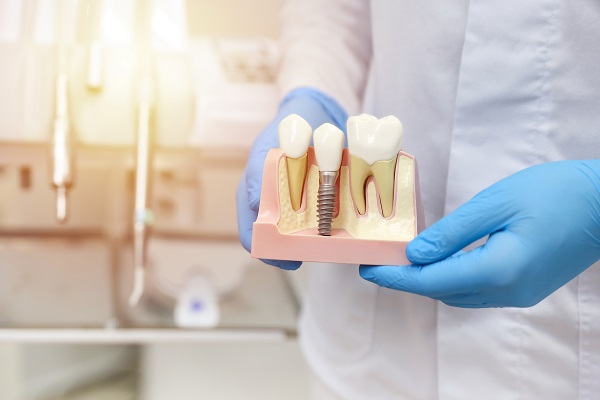The Steps of Dental Implant Surgery

Dental implant surgery involves inserting implants into your jawbone tissue. The procedure counts as oral surgery, and it involves the use of anesthetics. Implants are one of the popular restorations used in dentistry thanks to their bone preserving properties. They serve as artificial teeth roots, and they can be fitted with restorations like implants, bridges and dentures.
What to expect with dental implant surgery
Dental implant surgery is not for everyone. Patients need to be healthy enough to recover from the surgical process, and their jawbone should be thick enough to hold implants in place. The dentist will go over any health issues a patient has, the medication they take for their condition and if they have habits like smoking.
Also, people who are interested in getting implants should be willing to wait several months to complete the process. It requires a lot of commitment on the patient’s part.
During the initial consultation, the dentist will evaluate the patient’s mouth using tools like x-rays and 3D images. The patient’s medical history will also be thoroughly evaluated before determining if they should be eligible for implants.
Installation
The installation of implants often requires multiple stages over the course of roughly six months. The dentist might remove an existing damaged tooth in preparation for an implant. Bone grafts might be performed if the patient’s jaw is not thick enough for implants. It can take up to three months to recover from bone grafts, and patients should be fully healed before proceeding with implants.
Here is what the process looks like:
- The patient is given a shot of a local anesthetic to numb the area being worked on
- A cut might be made into the patient’s gums to expose the jaw
- A hole is drilled into the jaw and the implant is pushed into the hole. The bone tissues around the implant keep it in place
- The implant might be covered with a healing cap and any cuts made will be sutured. The patient might be prescribed antibiotics to help prevent infection
- The implant is given up to six months to fuse with bone tissues around it via osseointegration
- Once the implant has bonded with bone tissues around it, the dentist might reopen the incision made to attach an abutment to the implant. The area is stitched up and a restoration might be attached to the abutment. In some cases, the patient might need to come in for a third time for a restoration to be attached to the implant
Benefits
The benefits of choosing implants over other teeth replacement options include:
- Implants help to prevent the loss of bone tissues that typically occurs when teeth are lost
- Implants do not require special maintenance
- Implants are a permanent replacement for missing teeth that can last a lifetime
- Implants prevent the remaining teeth from becoming misaligned as they try to close the space created by missing teeth
Replace your missing teeth
Ready for a complete smile? Call or visit our Hanford clinic to set up an appointment with our dentist.
Request an appointment here: https://hanfordcosmeticdentist.com or call Rushi Panchal DDS at (559) 426-1124 for an appointment in our Hanford office.
Check out what others are saying about our dental services on Yelp: Dental Implant Surgery in Hanford, CA.
Recent Posts
Are you looking for a trained dental professional for dental implant surgery? Smart. When people choose dental implants to improve their oral health, they will need to undergo dental surgery. This choice makes it essential for them to be fully prepared to experience the dental implant placement process. Ready to learn more?Wondering why dental implant…
A dental implant restoration is a method of teeth replacement that offers long-term durability and a natural feel and function for patients. It involves the placement of a dental implant (a titanium dental post) into the jawbone, followed by attaching the abutment and prosthetic (crown, bridge or denture). The dental implant restoration process involves a consultation…
It is usually hard to determine the precise cause of TMJ disorder. Issues affecting the temporomandibular joint may originate from different potential causes, and ascertaining the right cause can help determine the course of treatment. Jaw injury is a common cause of TMJ disorder, but the condition does not develop immediately after the injury; in…
Experiencing a need for a denture repair? Unfortunately, dentures are extremely prone to accidents, which can result in damages such as cracks or chips. When this happens, a lot of wearers wonder what they should do next. The answer is simple, visit a dentist's office.Denture repair should always be done by a dentist, but why?…


